There are many possible causes for white tongue, and in some cases, it comes with an unpleasant odor and mouth dryness. To get rid of it, sometimes you just need to brush your teeth. But what should you do if that doesn’t help?

What white tongue is
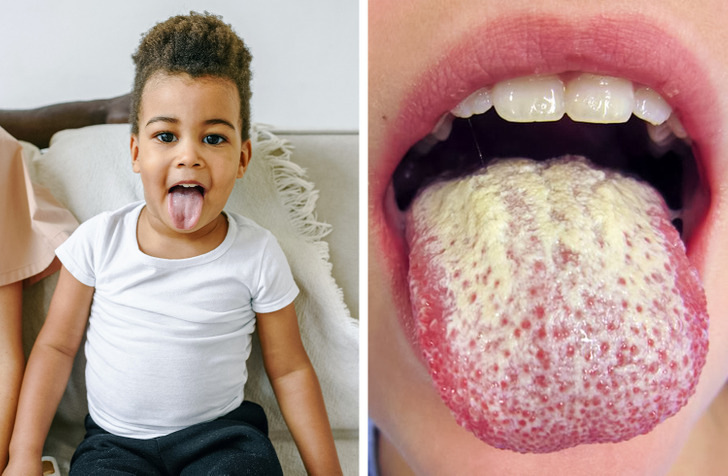
The white film may cover the entire tongue, part of it, or appear as spots. At the same time, an unpleasant odor and taste in the mouth may appear. It looks as if there are small white hairs on the tongue’s surface. In fact, they are buds covered with organic particles, bacteria, and dead cells.
White plaque on the tongue (which can also be yellow) may appear for different reasons, like due to irritation or because of an infection. It usually disappears after several days. If the situation doesn’t change for several weeks, and it’s painful to eat and talk, it’s best to see a doctor.
It’s important to note that the plaque may not only be white. While a pink tongue is normal, a brown tongue means the person drinks too much coffee or tea. A yellow tongue means there’s something wrong with the liver, and a red tongue is a sign that the person lacks vitamin B.
Why the tongue becomes white
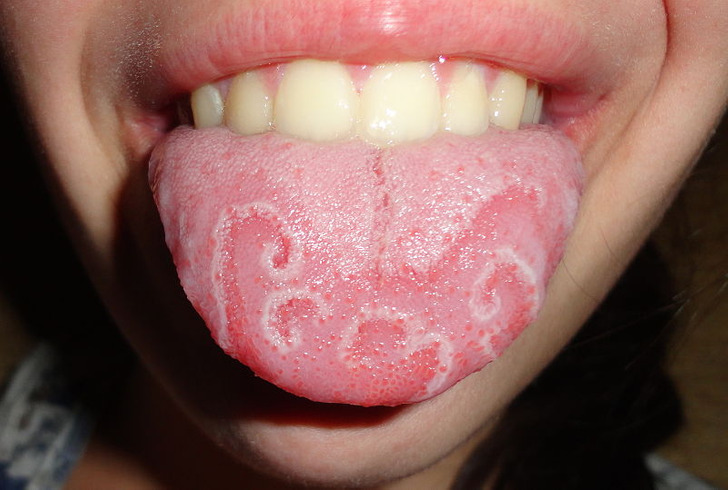
Usually, the tongue becomes white due to bacteria, leftover bits of food, or dead cells that get stuck in between the buds. Because of this, the buds may increase in size or become inflamed. This is how white spots on the tongue’s surface appear.
Sometimes, the plaque appears due to an illness. For example, the geographic tongue is also a condition where white spots appear on the tongue. It’s quite rare, and the causes are unknown, but the condition itself is often connected to eating foods that irritate the tongue. It may also be a reaction to stress, an illness, or hormonal changes.
Why white plaque appears on the tongue
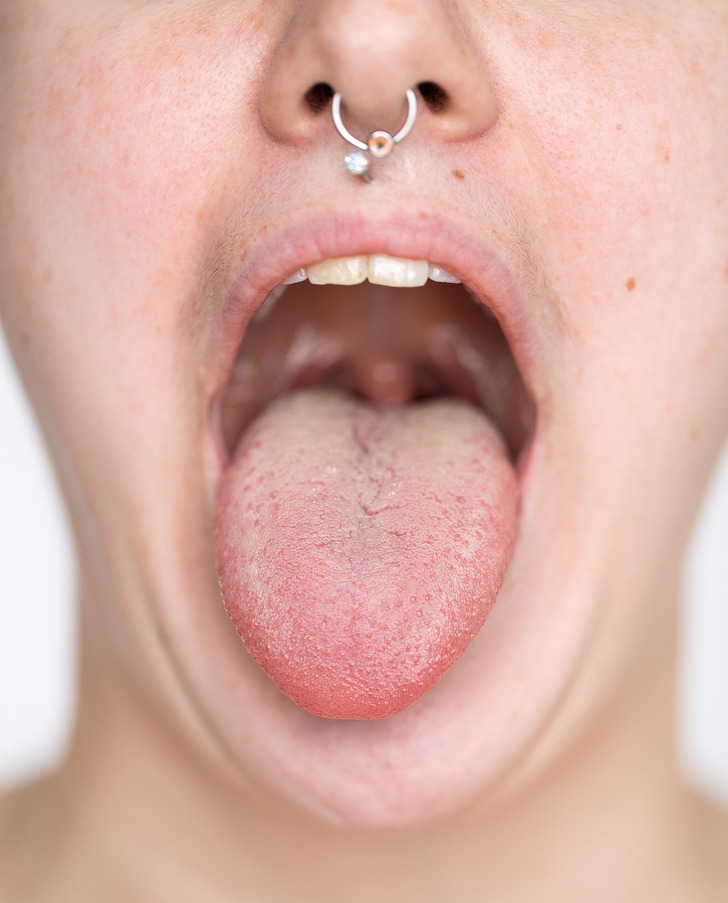
There are some things that make the appearance of white plaque on the tongue more probable:
- Age
- Taking antibiotics (white-yellow plaque appearing when there’s a fungal infection in the mouth)
- A diet that’s lacking enough fruits, vegetables, vitamin B12, and iron
- A weak immune system
- Bad mouth hygiene
- Dental prosthetics or other objects that can damage the tongue
- Dehydration and mouth dryness
What piercings have to do with white tongue
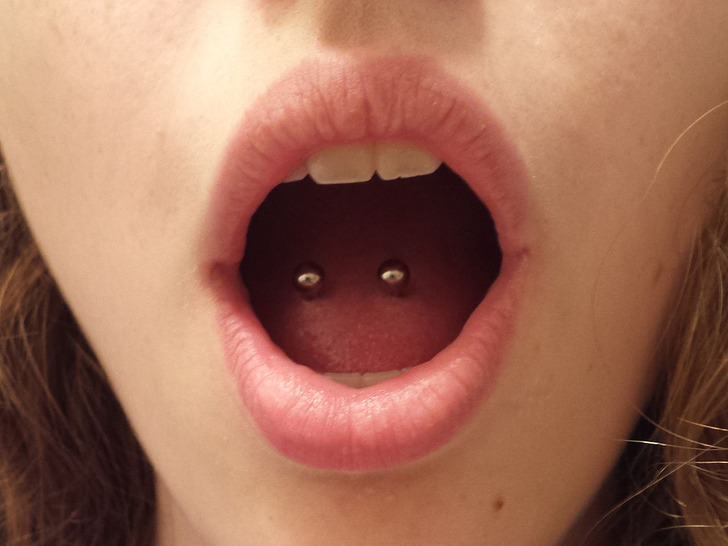
Right after piercing the tongue, there might be some white film present. This happens because the number of bacteria on the tongue increases, and it’s normal. Antibacterial mouthwash will help you get rid of it. Plus, there might be a ring around the piercings, which is normal too, and it means the tissue is healing.
If the plaque appears due to an injury (including piercings), the healing should take around 1.5 weeks. You should avoid irritants, such as hot, spicy, or sour foods and drinks.
How to get rid of white tongue at home
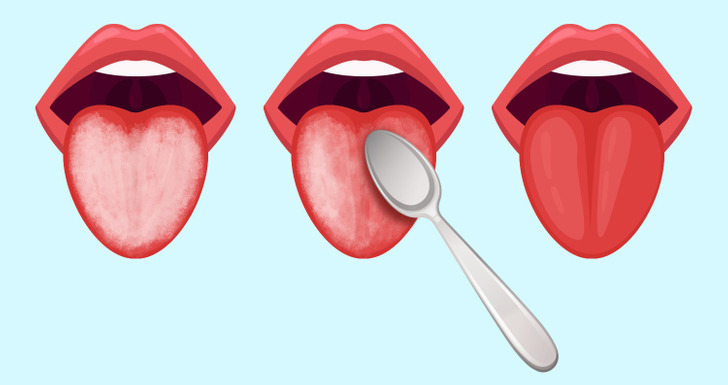
- Practice good mouth hygiene.
- Drink enough water.
- Brush your teeth using a soft toothbrush.
- Use a mild fluoride toothpaste — one that doesn’t contain sodium lauryl sulfate.
- Use fluoride mouthwash.
- Brush your tongue or use a tongue scraper to remove the white coating.
- Drink cold drinks through a straw.
- Avoid food and drinks that are spicy, salty, acidic, or very hot in temperature.
Who to talk to if you’re worried about your white tongue
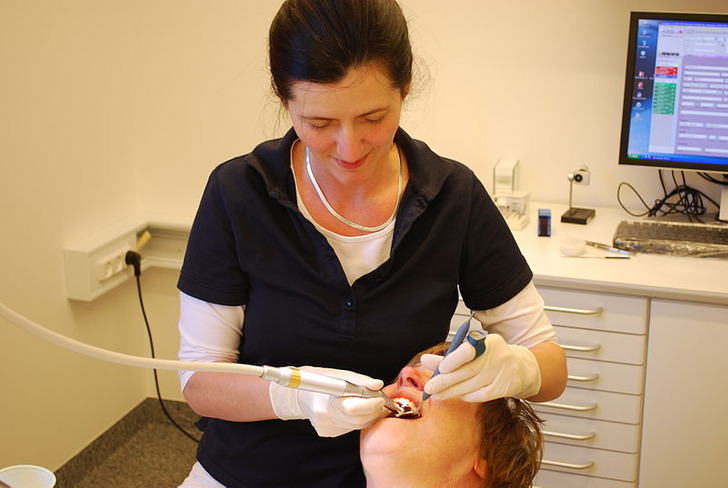
- Your dentist can help you remove the white film from the tongue and prescribe medications if needed.
- Your GP can diagnose the tongue, prescribe you certain medications and determine if the white tongue is an indicator of a more serious issue.
What do you do about white tongue?
Preview photo credit Genusfotografen (genusfotografen.se) & Wikimedia Sverige (wikimedia.se) / Wikimedia Commons, CC BY-SA 4.0, Martanopue / Wikimedia Commons, CC BY-SA 3.0
An 11-year-old tragically lost his life due to an online trend involving a common household item. Now, his grieving family is warning others about the dangers of this deadly challenge.
An 11-year-old boy, Tommie-Lee Billington from Lancaster, England, tragically passed away after participating in a dangerous TikTok challenge that involved inhaling harmful substances. The incident occurred during a sleepover at a friend’s house, where Tommie and his friend decided to try a viral trend they had seen on the app.
The challenge, known as “huffing,” involves inhaling toxic gases or solvents such as spray deodorant, glue, or dry shampoo to experience a temporary high. Unfortunately, as soon as Tommie inhaled the substance, his heart stopped, and despite immediate medical attention, he could not be revived. Doctors confirmed that he died instantly.

His grieving family is now speaking out, warning others about the hidden dangers of such social media trends. Tommie’s mother, Sherry, has taken to social media to raise awareness, urging parents to speak with their children about the deadly risks associated with these viral challenges.
In an emotional message on Facebook, Sherry expressed her deep pain and loss, writing, “This cost my son his life from trying something other kids are doing. Please talk to your children about the consequences of this. I have never felt pain like this. My whirlwind. My baby boy. You will forever be in my heart.”
Sherry’s heartfelt plea serves as a powerful reminder for parents to be vigilant about what their children are exposed to online. The family hopes that by sharing their story, they can prevent other families from enduring the same devastating loss and save lives by raising awareness of the dangers that lurk within seemingly harmless online challenges.
Sherry concluded her message by vowing to keep Tommie’s memory alive, saying, “I will make sure to the best of my ability that your name and your beautiful face will become the reason that other children’s lives will be saved, and other families don’t have to suffer this deep, deep hurt.”

Tommie-Lee’s death is not an isolated incident; it follows similar tragedies where other young people have lost their lives participating in dangerous online trends. His family’s warning is a sobering reminder of the potential harm that social media challenges can cause, and the need for open conversations between parents and children about the real risks of imitating what they see online.



Leave a Reply